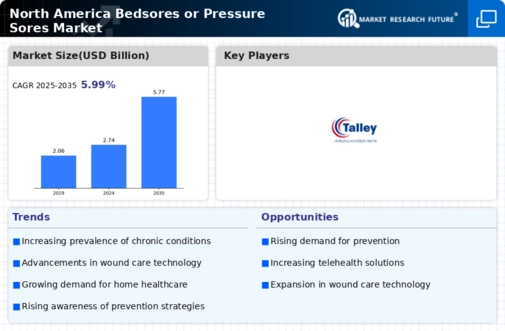Market Share
North America Bedsores Pressure sores Market Share Analysis
The market for pressure sores, also known as bedsores, is influenced by a combination of medical, demographic, and economic factors. One primary driver of this market is the aging population. As the global population continues to age, the prevalence of pressure sores tends to increase, as older individuals often face mobility issues and spend extended periods in bed or sitting. This demographic shift has a direct impact on the demand for pressure sore management products and services.
Furthermore, the rise in chronic health conditions contributes significantly to the growth of the pressure sore market. Conditions such as diabetes, paralysis, and vascular diseases can compromise blood circulation and skin integrity, making individuals more susceptible to developing pressure sores. The increasing incidence of these health issues amplifies the need for advanced and effective solutions in the market, including innovative prevention and treatment options.
Technological advancements play a crucial role in shaping the pressure sore market. Continuous research and development efforts lead to the introduction of new products and technologies that enhance prevention, diagnosis, and management of pressure sores. For instance, pressure-relieving mattresses, smart textiles, and sensor-based monitoring systems are among the innovations driving the market forward. Healthcare providers and patients alike benefit from these advancements, as they offer more efficient and patient-friendly solutions.
Government regulations and healthcare policies also impact the pressure sore market. Strict guidelines regarding patient care and pressure sore prevention in healthcare facilities drive the demand for high-quality products. Reimbursement policies and incentives for healthcare providers to invest in preventive measures can further stimulate market growth. Additionally, an increased focus on patient education and awareness campaigns can contribute to early detection and prevention, positively influencing the market dynamics.
Economic factors, including healthcare expenditure and affordability, significantly shape the pressure sore market. Countries with higher healthcare spending capabilities may witness a more robust market for advanced pressure sore management products. However, economic disparities can create challenges, as some individuals may face barriers in accessing expensive but effective solutions. Market players need to navigate these economic factors strategically to ensure the accessibility of their products to a broader population.
The competitive landscape of the pressure sore market is marked by the presence of various manufacturers, suppliers, and service providers. Intense competition fosters innovation and efficiency, driving companies to continually improve their products and services. Market players often engage in strategic collaborations, mergers, and acquisitions to strengthen their market position and expand their product portfolios. This competitive environment benefits consumers by providing a diverse range of options for pressure sore prevention and treatment.




Leave a Comment